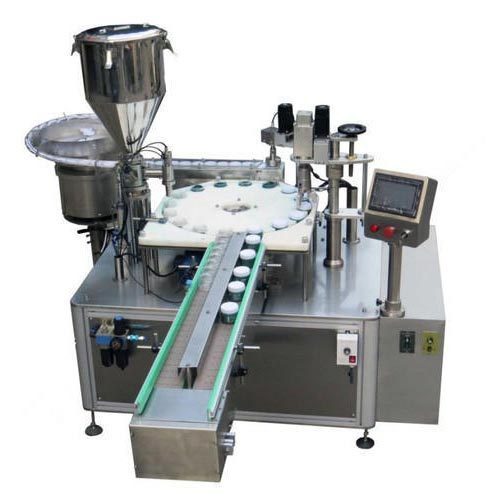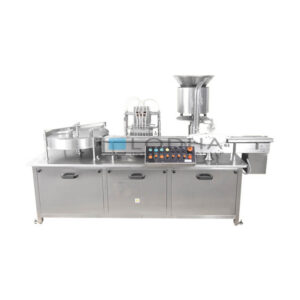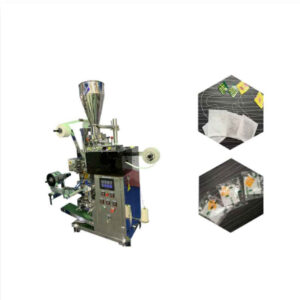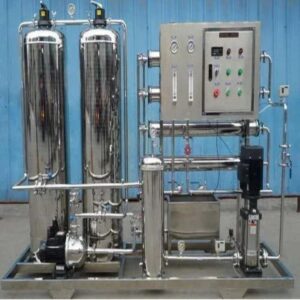Description
| Feature | Description |
|---|---|
| Filling Method | (e.g., Gravity, Pressure, Piston, Pump, etc.) |
| Filling Capacity | Maximum volume of product the machine can fill per cycle |
| Material | Material of construction (e.g., Stainless Steel) |
| Power Requirement | Electrical power needed (Voltage, Phase, Frequency) |
| Control System | Type of control system (Manual, Semi-Automatic, Automatic) |
| Speed | Maximum speed of filling cycles per minute/hour |
| Accuracy | Accuracy of filling (e.g., ±0.5%) |
| Cleaning System | Type of cleaning system (CIP, Manual, etc.) |
| Dimensions | Length x Width x Height |
| Weight | Total weight of the machine |
| Additional Features | Any additional features or options available |
A filling machine is a crucial component in the manufacturing and packaging industry, designed to automate the process of filling containers with various types of products such as liquids, powders, granules, and creams. These machines come in a variety of configurations to suit different production needs, ranging from small-scale operations to high-speed, large-volume manufacturing plants. The primary goal of a filling machine is to accurately dispense the desired amount of product into each container, ensuring consistency and efficiency throughout the packaging process.
Filling machines utilize advanced technology and precision engineering to achieve precise filling levels, minimizing product wastage and ensuring product quality. They can be integrated into existing production lines or operate as standalone units, offering versatility and adaptability to different manufacturing environments. Depending on the specific requirements of the product and packaging, filling machines may employ different mechanisms such as piston fillers, gravity fillers, volumetric fillers, or vacuum fillers.
In addition to their role in improving production efficiency, filling machines also contribute to enhancing product presentation and shelf appeal by delivering neatly filled and sealed containers. With the capability to handle a wide range of products and packaging formats, filling machines play a vital role in streamlining the manufacturing process and meeting the demands of today’s competitive market.
Understanding filling machine
Streamlining Production with Filling Machines
In the fast-paced world of manufacturing and packaging, efficiency is key. Filling machines have emerged as indispensable tools in the quest for streamlining production processes. From liquid to granular substances, these machines cater to a wide array of products, ensuring accuracy, consistency, and speed in filling containers. Let’s delve into the realm of filling machines and explore their various types and benefits.
Filling Machine
At the heart of packaging operations lies the filling machine. This multifaceted device is designed to automate the process of dispensing products into containers, be it bottles, jars, or pouches. Filling machines come in different shapes and sizes, each tailored to meet specific production requirements.
Liquid Filling Machine
For industries dealing with liquids, such as beverages, pharmaceuticals, and cosmetics, precision in filling is paramount. Enter the liquid filling machine, a specialized apparatus engineered to handle the delicate task of accurately measuring and dispensing liquids into containers. Whether it’s water, juice, or oil, these machines ensure consistency in fill levels, minimizing wastage and maximizing product quality.
Bottle Filling Machine
When it comes to packaging liquids, bottles are a popular choice due to their convenience and versatility. Bottle-filling machines are specifically designed to accommodate various bottle shapes and sizes, from small vials to large containers. These machines employ different mechanisms, such as gravity filling or piston filling, to efficiently fill bottles with the desired product.
Automatic Bottle Filling Machine
In today’s fast-paced production environments, automation is king. Automatic bottle-filling machines take efficiency to the next level by seamlessly integrating into production lines and reducing the need for manual intervention. With features like programmable settings and sensor-based controls, these machines ensure precise filling levels and consistent output, all while maximizing throughput.
The Advantages of Automatic Filling Machines
Automatic filling machines offer a plethora of benefits to manufacturers looking to streamline their operations. Firstly, they significantly reduce labor costs by minimizing the need for manual labor in the filling process. This not only cuts down on expenses but also improves overall efficiency and productivity. Moreover, automatic filling machines enhance product quality by minimizing human error and ensuring uniform fill levels across all containers.
Choosing the Right Filling Machine for Your Needs
Selecting the right filling machine is crucial to the success of any packaging operation. Factors such as the type of product, production volume, and container specifications must be taken into account when making this decision. Whether it’s a liquid-filling machine for beverages or an automatic bottle-filling machine for pharmaceuticals, investing in the appropriate equipment can make all the difference in optimizing production efficiency and maintaining product integrity.
Types of filling machine machine
Gravity-Filling Machines: Gravity-filling machines rely on the natural force of gravity to fill containers with liquid products. These machines feature a tank or reservoir positioned above the filling nozzles. As the containers are placed beneath the nozzles, the liquid flows down due to gravity, filling the containers to the desired level. Gravity-filling machines are suitable for filling thin to medium-viscosity liquids and are often used in industries such as beverages, oils, and cleaning solutions.
Piston Filling Machines: Piston-filling machines utilize a piston mechanism to dispense precise amounts of liquid into containers. The piston draws the product from a reservoir and then dispenses it into the containers through a nozzle. These machines are highly accurate and can handle a wide range of viscosities, making them suitable for filling products like creams, pastes, and sauces.
Volumetric Filling Machines: Volumetric filling machines operate on the principle of displacement, where a predetermined volume of product is measured and dispensed into containers. These machines can be configured with different mechanisms such as rotary valves, gear pumps, or peristaltic pumps to accommodate various types of products, including liquids, granules, and powders. Volumetric filling machines are widely used in industries such as food, pharmaceuticals, and cosmetics.
Vacuum Filling Machines: Vacuum filling machines are ideal for filling liquids into containers without introducing air or oxygen. These machines work by creating a vacuum inside the container, which draws the liquid from a reservoir into the container. Vacuum filling is particularly suitable for filling delicate or foamy products like wine, spirits, and syrups, as it minimizes the risk of oxidation and ensures product integrity.
Net Weight Filling Machines: Net weight filling machines are designed to fill containers based on their weight rather than volume. These machines use load cells or weighing scales to accurately measure the weight of the containers as they are filled. Once the desired weight is reached, the filling process stops automatically. Net weight filling machines are commonly used in industries where precise dosing is critical, such as pharmaceuticals, chemicals, and food.
Applications of filling machine machine
Food and Beverage Industry: Filling machines are widely used in the food and beverage industry for filling bottles, cans, pouches, and containers with various products such as juices, sauces, dairy products, oils, and condiments. These machines ensure accurate filling levels, prevent product wastage, and maintain product integrity, meeting the stringent quality standards of the food and beverage sector.
Pharmaceutical Industry: In the pharmaceutical industry, filling machines play a critical role in accurately dosing and filling medications, syrups, creams, and other pharmaceutical products into bottles, vials, and tubes. These machines adhere to strict regulatory requirements, ensuring precise dosage delivery, product safety, and compliance with pharmaceutical standards.
Cosmetics and Personal Care Products: Filling machines are essential for packaging cosmetics, skincare products, hair care products, and toiletries into containers such as jars, bottles, tubes, and sachets. These machines enable precise filling of creams, lotions, serums, shampoos, and perfumes, maintaining product consistency, aesthetics, and shelf appeal.
Chemical and Industrial Products: Filling machines are utilized in the chemical and industrial sectors for filling containers with a wide range of products such as lubricants, solvents, detergents, adhesives, and cleaning chemicals. These machines ensure accurate dosing, prevent spillage and enhance workplace safety by minimizing exposure to hazardous substances.
Automotive Industry: Filling machines are employed in the automotive industry for filling fluids such as motor oil, coolant, brake fluid, and windshield washer fluid into containers and reservoirs. These machines facilitate efficient and precise filling, ensuring the optimal performance and longevity of automotive components and systems.
Household Products: Filling machines are used to package household products such as laundry detergents, dishwashing liquids, household cleaners, and air fresheners into bottles, pouches, and containers. These machines enhance productivity, reduce packaging costs, and improve product presentation, catering to the diverse needs of consumers.
Agricultural and Horticultural Products: Filling machines are employed in the agricultural and horticultural sectors for packaging fertilizers, pesticides, herbicides, and seeds into bags, bottles, and containers. These machines enable accurate dosing, minimize product wastage, and facilitate efficient distribution and application of agricultural inputs.
Functionalities of filling machine machine
Accurate Dosage Control: Filling machines are equipped with mechanisms that allow precise control over the amount of product dispensed into each container. This ensures consistency in fill levels and prevents under or overfilling, which is critical for maintaining product quality and meeting regulatory standards.
Versatility: Filling machines are versatile and can handle a wide variety of products, including liquids, creams, powders, granules, and semi-viscous substances. They can accommodate different container shapes and sizes, making them suitable for diverse packaging needs across various industries.
Adjustable Filling Speed: Many filling machines feature adjustable filling speeds, allowing operators to optimize production throughput according to specific requirements. This flexibility enables manufacturers to meet varying demand levels without compromising on efficiency or product quality.
Ease of Operation: Modern filling machines are designed with user-friendly interfaces and intuitive controls, making them easy to operate and adjust. This reduces the need for extensive training and minimizes the risk of human error, ensuring consistent and reliable performance.
Cleaning and Maintenance Features: Filling machines are equipped with features that facilitate easy cleaning and maintenance, such as quick-change parts, tool-less disassembly, and access to critical components. This ensures minimal downtime and maximizes equipment uptime, contributing to overall production efficiency.
Integration with Packaging Lines: Filling machines can be seamlessly integrated into existing packaging lines, allowing for smooth coordination with other equipment such as capping machines, labeling machines, and conveyor systems. This integration streamlines the production process and minimizes the handling and transfer of filled containers.
Product Preservation and Sterilization: Certain filling machines are equipped with features for preserving product integrity and ensuring sterility, particularly in industries such as pharmaceuticals and food processing. This may include processes such as inert gas flushing, aseptic filling, and sterilization of contact surfaces.
Data Monitoring and Reporting: Advanced filling machines may incorporate data monitoring and reporting capabilities, allowing operators to track key performance metrics such as fill accuracy, production output, downtime, and maintenance schedules. This data can inform process optimization efforts and facilitate continuous improvement initiatives.
Safety Features: Filling machines are equipped with safety features to protect operators and prevent accidents, such as emergency stop buttons, guarding, and interlocks. Compliance with safety standards and regulations is essential to ensure a safe working environment and prevent potential hazards.
Frequently Asked Questions
- What types of products can be filled using filling machines?
Filling machines can handle a wide range of products, including liquids, creams, gels, powders, granules, and semi-solid substances.
- How do I choose the right filling machine for my product?
The choice of filling machine depends on factors such as the type of product, viscosity, production volume, container size, and desired filling accuracy.
- Are filling machines suitable for small-scale production?
Yes, there are filling machines available that cater to small-scale production needs, offering flexibility, affordability, and ease of operation.
- Can filling machines handle different types of containers?
Yes, filling machines can be configured to accommodate various container shapes and sizes, including bottles, jars, cans, pouches, and tubes.
- What is the difference between semi-automatic and automatic filling machines?
Semi-automatic filling machines require some manual intervention, such as container placement and product initiation, while automatic filling machines operate independently once set up.
- How accurate are filling machines in dispensing products?
Filling machines are designed to provide high levels of accuracy in product dosing, with precision typically measured in milliliters or grams, depending on the product type.
- Do filling machines require regular maintenance?
Yes, like any other machinery, filling machines require regular maintenance to ensure optimal performance, prevent breakdowns, and prolong lifespan.
- Are filling machines compatible with different types of packaging materials?
Yes, filling machines can work with a variety of packaging materials, including glass, plastic, metal, and flexible films, depending on the specific machine configuration and application.
- Can filling machines be integrated into existing production lines?
Yes, filling machines can be seamlessly integrated into existing production lines, allowing for smooth coordination with other equipment such as capping machines, labeling machines, and conveyors.
- What safety features are available on filling machines?
Filling machines are equipped with various safety features, such as emergency stop buttons, guarding, interlocks, and safety sensors, to protect operators and prevent accidents during operation.





